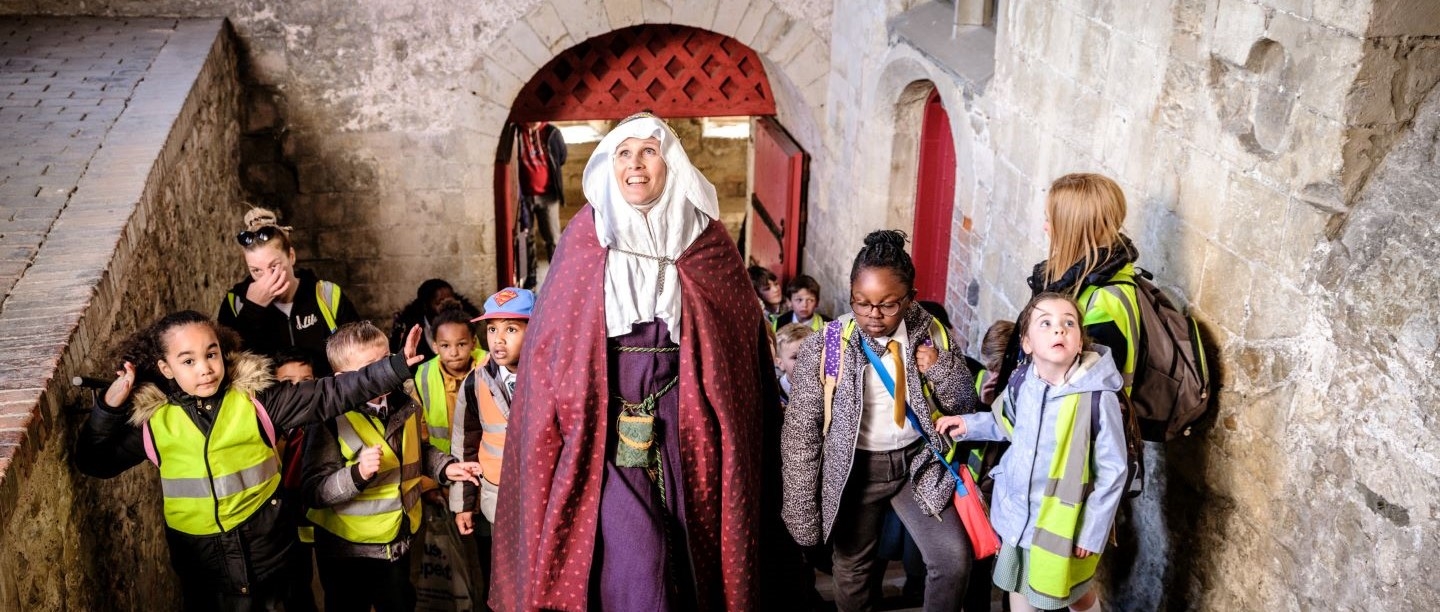1. STONEHENGE, WILTSHIRE
Are you currently teaching your key stage 2 students about late Neolithic hunter-gatherers and Bronze Age religion? It would be hard to find a better site to help you cover the topic than the world-famous Stonehenge, the most outstanding prehistoric monument in the British Isles. Link learning to geography, maths and science by discussing how our ancestors might have moved and raised the stones, and cover literacy and speaking and listening skills by examining myths and legends linked to the site and asking your class to come up with their own theories about how the monument was used.
2. BATTLE ABBEY, EAST SUSSEX
What better way to learn about 1066 and the Battle of Hastings than by walking in the footsteps of William the Conqueror and King Harold at Battle Abbey? Discover the story of 1066 by standing on the spot where the battle took place and learn all about the events leading up to one of the most famous dates in history. The abbey remains allow you to delve further into monastic life and the impact that William’s victory had on Britain.
3. DOVER CASTLE, KENT
Support students’ learning in a fun and engaging way with a visit to Dover Castle, which has played an important part in history for 2000 years. Discover the Roman lighthouse, the oldest in the country, then see The Great Tower to learn more about the palace of Henry II. Book our education room to dress up as a medieval lady or knight, and explore the medieval tunnels. Finish up at the Secret Wartime Tunnels, where you can learn more about WWI, the role of the WWI Fire Command Post and how Operation Dynamo, the Dunkirk evacuation of May 1940, was masterminded.
Find out more4. OSBORNE, ISLE OF WIGHT
Discover the private lives of Queen Victoria and her family. Explore the house and grounds, including the beach and the Swiss Cottage with its own gardens, once tended by the royal children. Dress up as a Victorian, and see the replica grocery based on the model once reserved for the Royal children’s education at Swiss Cottage. Your pupils can try weighing out coffee and chocolate, and see if they can work out how much it would have cost in the 1850’s. Round off your trip with a visit to the exotic Durbar room, exploring the gifts and paintings given to Queen Victoria as Empress of India.
5. KENILWORTH CASTLE, WARWICKSHIRE
Kenilworth Castle has been a major military stronghold, a royal palace and an inspiration to writers and artists for 900 years. A key part of its history was when Elizabeth I gifted it to her favourite, Robert Dudley, who transformed it into a palace for her delight. Help students to imagine the opulence and splendour of Elizabethan Kenilworth by walking in the Tudor queen’s footsteps in the Elizabethan garden and exploring the tower built by the Earl of Leicester to court her. Bring students’ learning to life by investigating the property’s history and restoration in the 20th century.
6. HOUSESTEADS ROMAN FORT - HADRIAN'S WALL, NORTHUMBERLAND
The Roman Empire and its impact on Britain is a key topic for primary schools, and a visit to Housesteads Roman Fort is a unique experience to help further their learning. Standing high on the wild Whin Sill escarpment, Housesteads is the most complete example of a Roman fort anywhere in Britain. With a history that goes back almost 2000 years, Housesteads offers a great insight into what life was like for the 800 soldiers based there.
7. DOWN HOUSE, KENT
Down House, where Charles Darwin lived with his family from 1842 to 1882, is a site of outstanding significance with strong links to many areas of curriculum study. Extend science learning with a visit to the exhibition which will guide you through Darwin’s voyage aboard the Beagle from 1831-36, his scientific discoveries and the impact of his revolutionary theories on Victorian society. Boost students’ historical knowledge by exploring the house’s authentic Victorian interiors and reflecting on the culture in which Darwin and his wife Emma raised their children.
8. BEESTON CASTLE, CHESHIRE
Beeston Castle, with its impressive hilltop location and natural defences, has been home to prehistoric settlers and great barons, has acted as a defence against aristocratic rivals and was even an important English Civil War stronghold. Students can gain important historical knowledge of castle life across the centuries going back to medieval times. Outside the castle, they can explore the prehistoric landscape and visit the museum to look at artefacts found on site.
9. LULLINGSTONE ROMAN VILLA, KENT
Study art and history simultaneously at Lullingstone Roman Villa. One of the most important and complete examples of its kind in Britain, Lullingstone sheds light on the lives of its affluent Roman occupiers through an outstanding collection of mosaics, wall paintings and archaeological finds. Students can take a look at the remains of an extremely rare “house church”, among the earliest evidence for Christianity in Britain, and learn how Roman craftspeople created those beautiful mosaics and paintings.
10. PEVERIL CASTLE, DERBYSHIRE
Founded soon after 1066 by William Peverel and mentioned in the Domesday survey, Peveril Castle is one of England's earliest Norman fortresses. The keep, which is the castle’s most striking feature, was built by Henry II in 1176 after it came into royal hands. Learn all about Peveril’s role as the administrative centre of the Royal Forest of the Peak, a hunting preserve for monarchs since the 11th century to give students further insight into medieval life.

